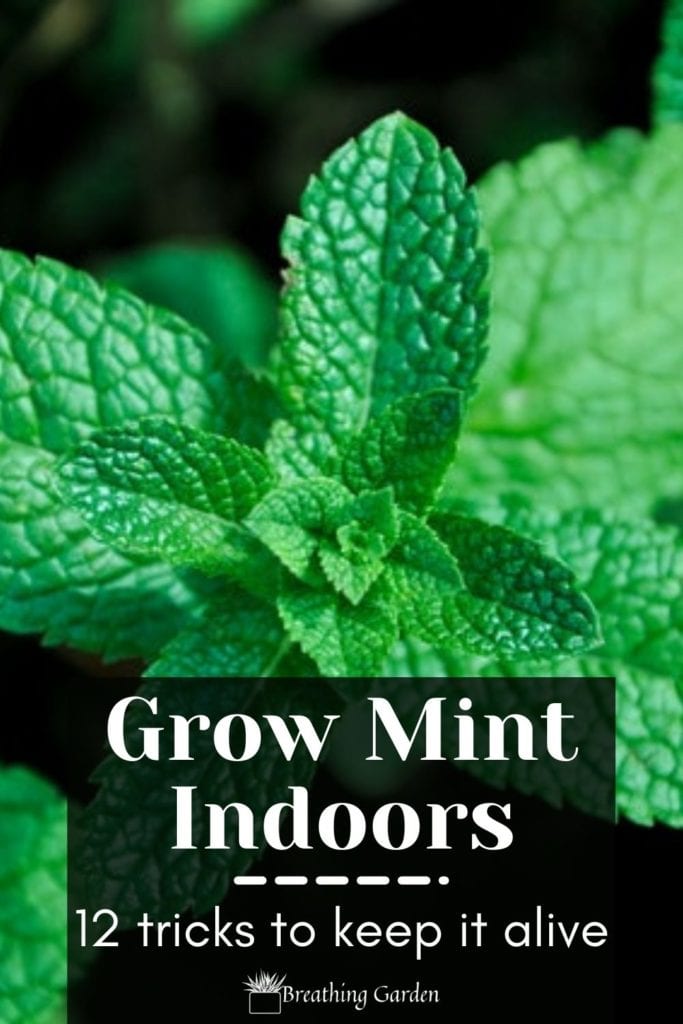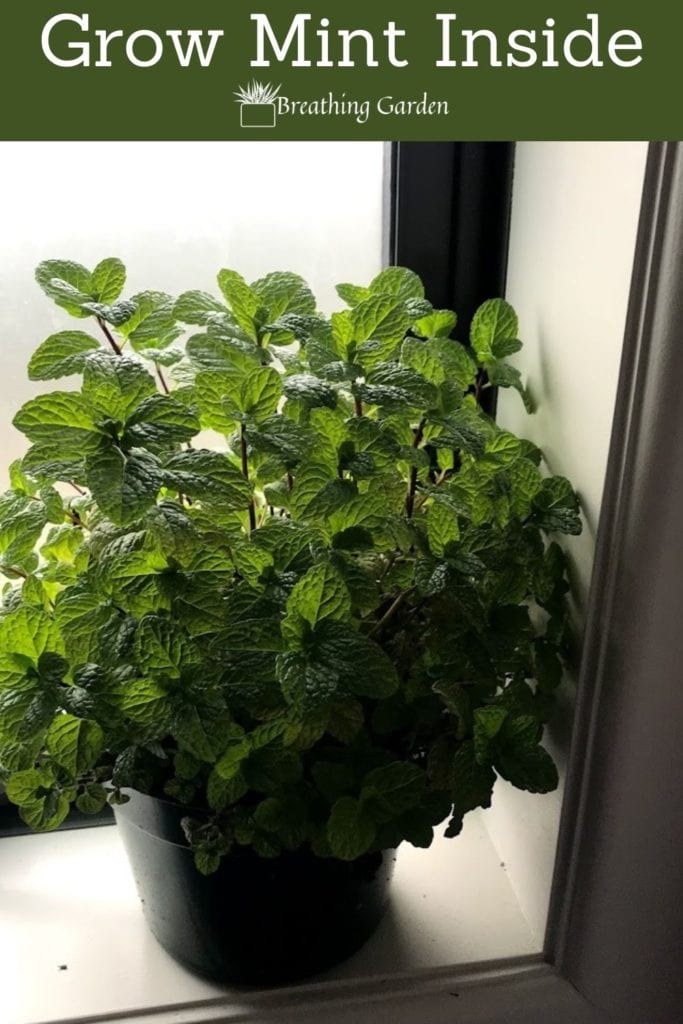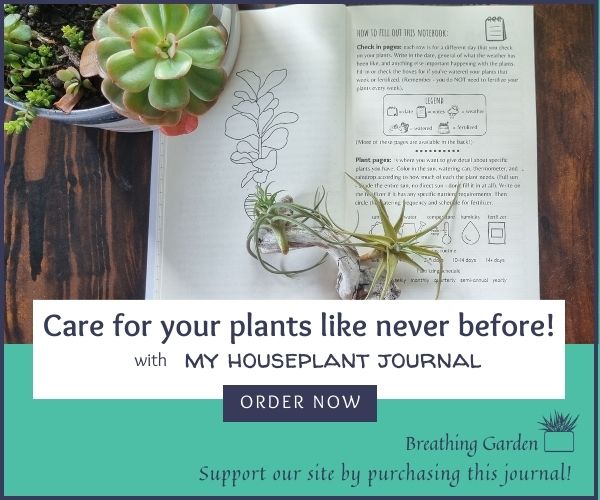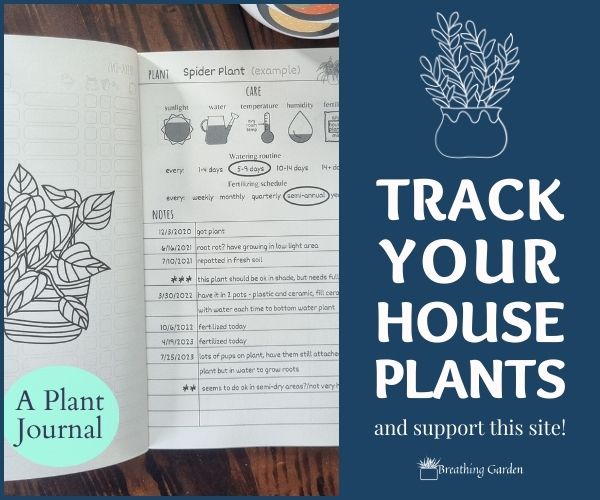Mint is such a flavorful herb that’s fairly easy to grow and adds a great scent to any room it grows in. Growing mint indoors is simple and will be a great addition to any indoor plant collection!
*This post may include affiliate links. When you purchase items from these links, we will receive a small commission, at no extra cost to you, to help support this website. Thank you for your support! Read more ->
Mint is an incredibly versatile plant that grows so wildly that it has to be contained when planted in beds outdoors. That’s a plus for growing your mint in a container inside, so you won’t have to worry about it taking over the garden.
The Best Mint Varieties for Indoor Growing
The first step when learning how to grow mint indoors is deciding which mint varieties you want to grow. There are more than 600 different mint species featuring a wide range of flavors. These are some of the best varieties to grow for both flavor and their ability to thrive inside.
Peppermint

Peppermint is one of the most common flavors of mint to see in your everyday life. This is the one most often turned into tea, and is a fairly strong flavor. Often times this flavor is also added to chocolates, liqueurs, and candies.
Peppermint is a great choice if you are a tea lover and want to brew fresh herbal tea.
Spearmint
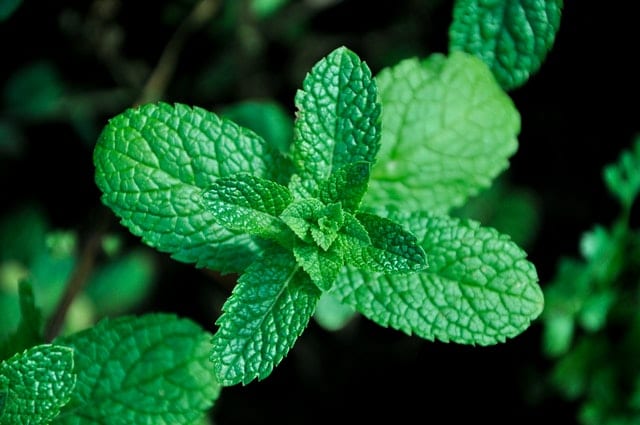
The leaves of the spearmint plant are slightly smaller than peppermint plant leaves. Another common flavor of mint, this is the one more often paired with savory dishes. Or used in mojitos.
If you do decide to grow this plant outside instead of indoors, spearmint plants are a natural mosquito repellant, and bees love spearmint.
Apple Mint
Apple mint has a milder flavor than peppermint, and has a slightly fruity flavor. This unique mint variety has beautiful purplish-white flowers that make apple mint a gorgeous houseplant.
Ginger Mint
Ginger mint is another good choice for a type of mint to grow indoors, as it pairs well in desserts. It still has the cooling effect of mint, as it’s still a mint plant, but this also gets its name from the way there’s a slight spicy feeling at the end of consuming this mint, like you would feel with ginger.
How to Grow Mint Indoors

Now that you’ve decided on which type of mint to grow (or grow all of them, just don’t forget to label which is which!) now it’s time to get to how to grow mint indoors! These are a fairly simple plant to grow, and likely you’ll have more mint than you know what to do with! (which will be discussed at the bottom of this page)
1. Choose wide containers
One of the best tips for growing mint indoors is to choose wide, shallow containers. The width is more important than the depth. Mint has a fairly shallow root system, so it doesn’t actually need the depth.
That’s why it’s better to grow mint in wide containers, and the more surface space you have, the more mint you can harvest.
Planting in shallow containers allows the runners to produce new plants and shoots. You can always replant the mint into a larger container after a few months if it seems like it’s outgrowing it’s space and you want more mint.
Or control the amount of mint growing by keeping it in a smaller container.
2. Light requirements

Mint loves full morning sun with partial shade in the afternoon. If you have only one or two pots of mint, it’s easy to move them around if you work from home, but for consistency, it’s best for them to have a permanent home near a window.
If you don’t have a spot where it will get full morning sun and afternoon shade, put the plant in a room that is brightly lit throughout the day by natural light (without ever having direct sunlight).
3. Water needs
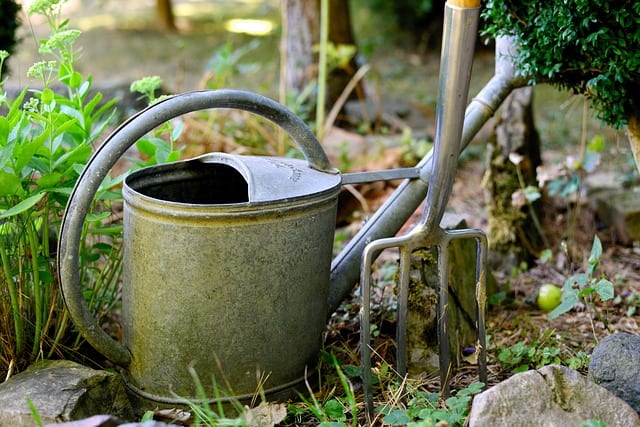
Mint is a thirsty plant. It thrives on more water than many other plants. Depending on the season and the size/type of container, mint will need to be watered every other day to every few days.
Mint is an easy plant to tell if it’s dry by just feeling the leaves. They wilt really quickly, but will perk up when watered.
Mint also loves humidity, so try to keep it in a humid area or have a humidifier near it.
4. Grow the mint at room temperature
Mint likes the sweet spot of being at a comfortable room temperature. Growing mint indoors, try to keep it in a room that doesn’t get too cold.
Keep it away from heating elements, because that’ll dry up the plant (and mint loves moisture), but keep it in a warmer room during winter months.
5. Pinch off the flowers

Mint tastes best if you harvest the sprigs before you allow the plant to flower. This also helps keep them from cross pollinating if you do have multiple varieties of mint near one another.
Pinching off the flowers also extends the harvesting season (although it’ll be almost year round when growing indoors). If you pinch off the flowers, or flower buds, the plant can continue focusing on growing the leaves instead of putting all of its energy into the flowers.
6. Plant your mint in separate containers
Mint has a remarkably invasive and quick-growing root system. If you plant your mint with other herbs, your mint plants will quickly overtake the other plants.
To avoid this, be sure you contain your mint in their own pots. Especially if you are growing different varieties of mint, because they may become one plant instead of each having their own flavor.
7. Encourage bushiness and harvest as needed

To make your mint plants as busy as possible, pinch the tops of the plants off right after you plant them. This makes the plants grow out instead of just up!
Mint is a very fast growing plant, and it’s really up to you on how much you want to harvest or prune back the plant. Read how to prune herbs here.
For optimal growth, don’t take the plant down to more than 1/3 of the original height (keep some of the leaves on the plant). Take from various places of the plant if you are just using a few at a time, or cut most of the height off!
8. Rotate your mint plants
It’s good to rotate any plants regularly, so they don’t grow just to one direction. Mint is the same! When growing mint indoors, rotate the pots every three to four days to ensure that your entire plant gets the benefit of the warm sunlight on all of its sides.
9. Minimal fertilization
Mint grows well without fertilizer, but you can fertilize your mint plants if you want. If you do, fertilize once in the spring with a water-soluble fertilizer.
Too much fertilizer can change the flavor of your mint’s leaves.
10. Watch out for bugs
Some people may say that mint is not a plant that aphids are attracted to, but it can still succumb to aphids and whiteflies. Look for an odd dusting around your indoor mint plant as a tell-tale sign that you may have aphids. Spray the underside of the leaves with a soapy water to get rid of the aphids!
Also, if you do see aphids on your plant, quarantine that plant and move it away from others so there’s less of a chance any other plants will get infested with aphids.
Learn other ways to get rid of aphids here.
11. Propagate for more plants
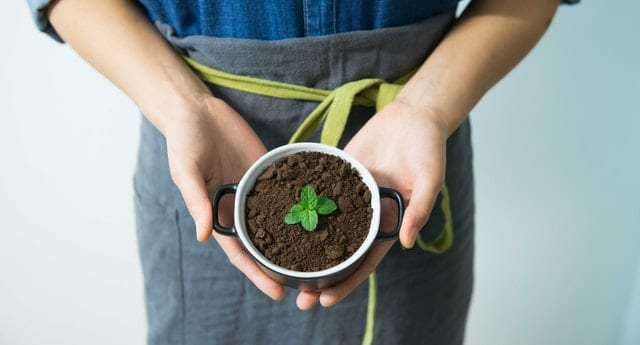
If you want more mint plants, you can easily take cuttings from your well-established plants. Cuttings should be from three to four inches long. Place the cuttings in water after you remove the lower leaves. In 10-14 days, you’ll have a small root system, and you can plant them in containers.
12. Freeze your excess mint
If you’re growing mint indoors, you’ll quickly learn that your harvest will be sizeable. The good news is that mint freezes wonderfully. You can freeze the mint leaves in a plastic freezer bag.

Alternatively, you can put mint leaves in an ice cube tray and fill the slots with water. Then, remove the mint cubes from the tray and store them into a freezer bag. You can use these minty cubes to flavor our beverages or blend them up for blended cocktails.
Hopefully these 12 tricks help you discover how to grow mint indoors and answer any questions you may have had about the process and how to keep your mint alive!
Pin It!
Want to keep these plant ideas for later? Save them to Pinterest!
